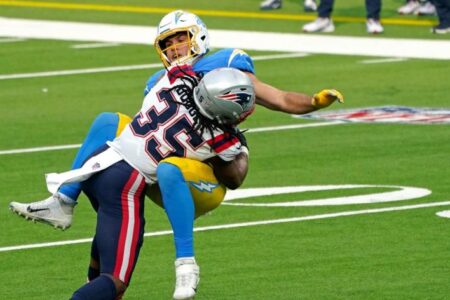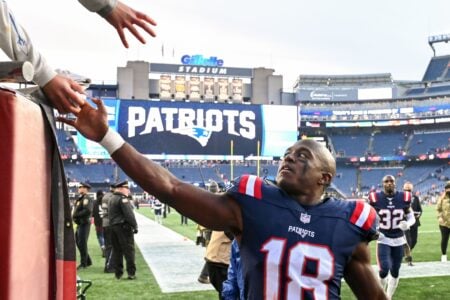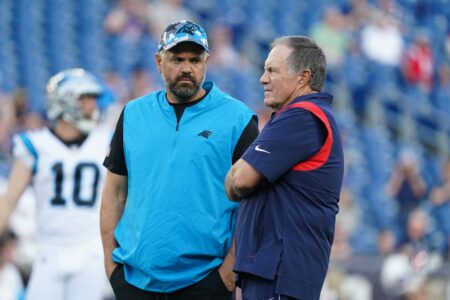- Joined
- Sep 9, 2008
- Messages
- 32,634
- Reaction score
- 23,169
Registered Members experience this forum ad and noise-free.
CLICK HERE to Register for a free account and login for a smoother ad-free experience. It's easy, and only takes a few moments.It's gotten scary out there.
A few things:
- What is a scrape exchange?
- What is fold blocking?
- His name is Casillas.
- You're unusual in forecasting "exclusively nickel". Please say more about that.


That's interesting because I would argue JUST the opposite. On of the great match ups that the Pats have is the availability of a 270 lb LB. THAT's the guy you want tackling MLynch, not Collins. And conversely, wouldn't you want your extraordinarily fast LB chasing after the elusive QB than the 270lb one. Hightower is fast for his size, but necessarily "fast"So once again the argument is that if anybody spies Wilson it should be Hightower. I'd also argue that if anybody WillieMacs Lynch it should be Collins. I'd further argue that Collins and Hightower should exchange roles at times just to mess with Wilson's head.
This is a nice post PP. How did you add the X's and O's?Here is a good illustration of scrape exchange:
View attachment 8255
Where B is the backer (let's say Hightower) scraping "over the top of the play" and coming down to meet the QB keep. That is, he "shadows" the QB in this particular play and comes to meet him in the gap that the DE preserves for him by sealing to the inside or acting as backside pursuit to the RB (could this be Wilfork?). When B scrapes, he leaves his position open, and the S comes down or cheats down to fill it. That's the exchange. Since I believe we will be in nickel, there will be another S on top, and one less lineman than is depicted in this diagram.
Fold blocks are exchanged blocking assignments used by partnering linemen to either cut off the flow of a fast moving backer who, in this instance, would emerge from scraping into the backfield (again, I envision Hightower) to choke the read option, or to block a down lineman. Fold blocking is very effective if done right because it gives the offense the advantage of angles. You block at an angle and so it’s easy to disrupt the path of a flowing backer or down lineman because you’re not blocking him straight up, but coming at his side which I understand is an effective path disruptor.
View attachment 8258
The reason I keep mentioning Hightower when I talk about scraping is because he has evolved into a top-notch scraper as he has excellent vision, patience, and instincts. He has a knack for "shadowing" a play without getting tied up or sucked into the blocking. There was a GIF posted in this forum showing how his scrape over the top killed a run play in the Ravens game. I forgot where it is located. If I can find it, I will post here.
And the reason I envision us being in nickel is because I feel we will go with a minimal DL as Seattle doesn't believe in a stout pocket. Their pocket is always fluid (as Wilson is very quick on his feet) and moves at a moment's notice which defeats the purpose of going with a heavy line that would penetrate into the backfield.
I think our linebackers will be very active, and they are best assisted by a hybrid nickel which can add another level of deception in rolling up various personnel to the line in a variety of package so Wilson will not always know who is the spy, who will scrape, or who will simply drop back.
Seahawks have read option in their pedigree, but its not read option you have to scheme for when it comes to stopping Wilson. He's actually most dangerous when the pocket breaks down and Wilson can escape defensive lineman to get 20 yards downfield. Or when he's scrambling after the pocket breaks down and suddenly a receiver is open downfield for 30 yards. It happens multiple times in just about every game.
This is a great find PP. Interesting that once again most of the photos show a look where the RB is running counter to the QB. In other words the QB is running more like a bootleg action than a true read where the RB and QB start in the same direction.
Great article for explanation and ideas, but I'm not sure it totally hangs together. The first part reads as if the recommendation is "Deceive the QB by defending the read option in multiple ways"; the second part reads as if it recommends a One Best Way to defend the read option.
One could adapt the article's recommendation to say "The unblocked end should always crash down, and sometimes an LB should scrape to fill his spot (in which case it would be a mistake for the QB to keep the ball) and sometimes the LB should not (in which case it would be a a mistake to hand off). But I can't see leaving the defensive left edge totally un-set in any formation.
Ken might argue that the unblocked end should always run at the QB and hit him, whether or not he has the ball. A variant might be that the unblocked end always heads for the QB, but if he's sure that the QB gave up the ball, then he redirects to the RB, since whoever does meet Lynch might need help getting him down anyway.
This is a great find PP. Interesting that once again most of the photos show a look where the RB is running counter to the QB. In other words the QB is running more like a bootleg action than a true read where the RB and QB start in the same direction.














